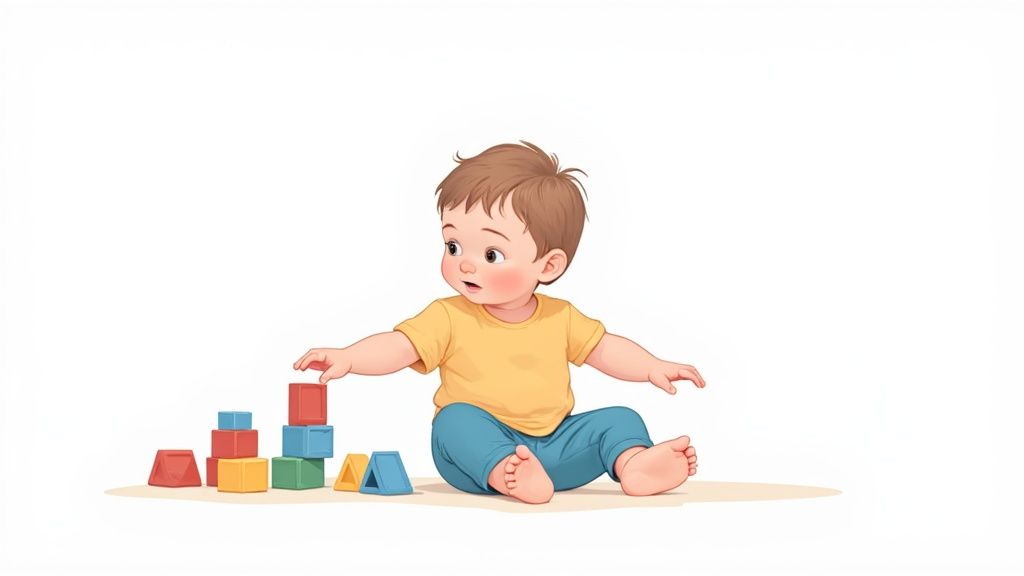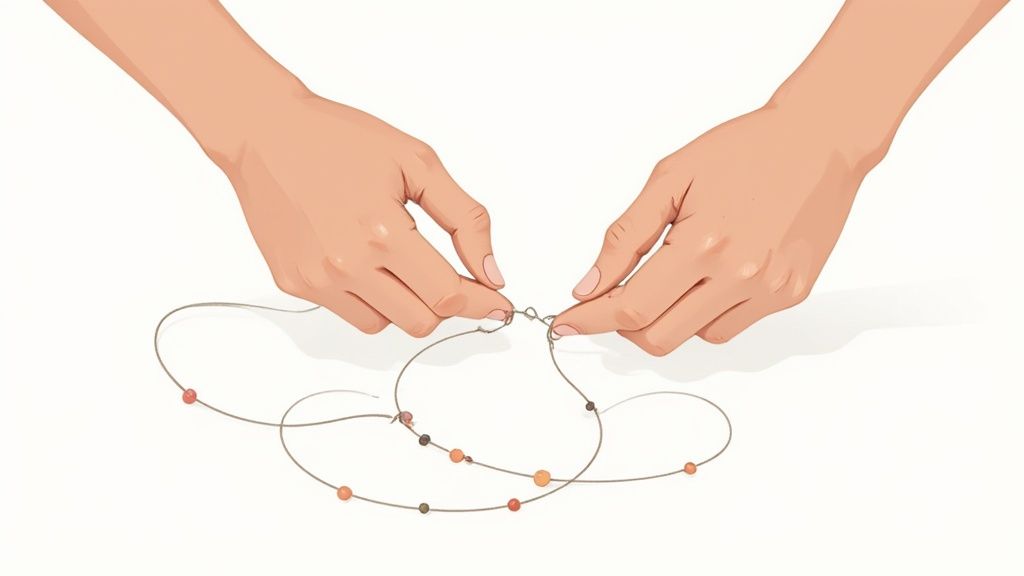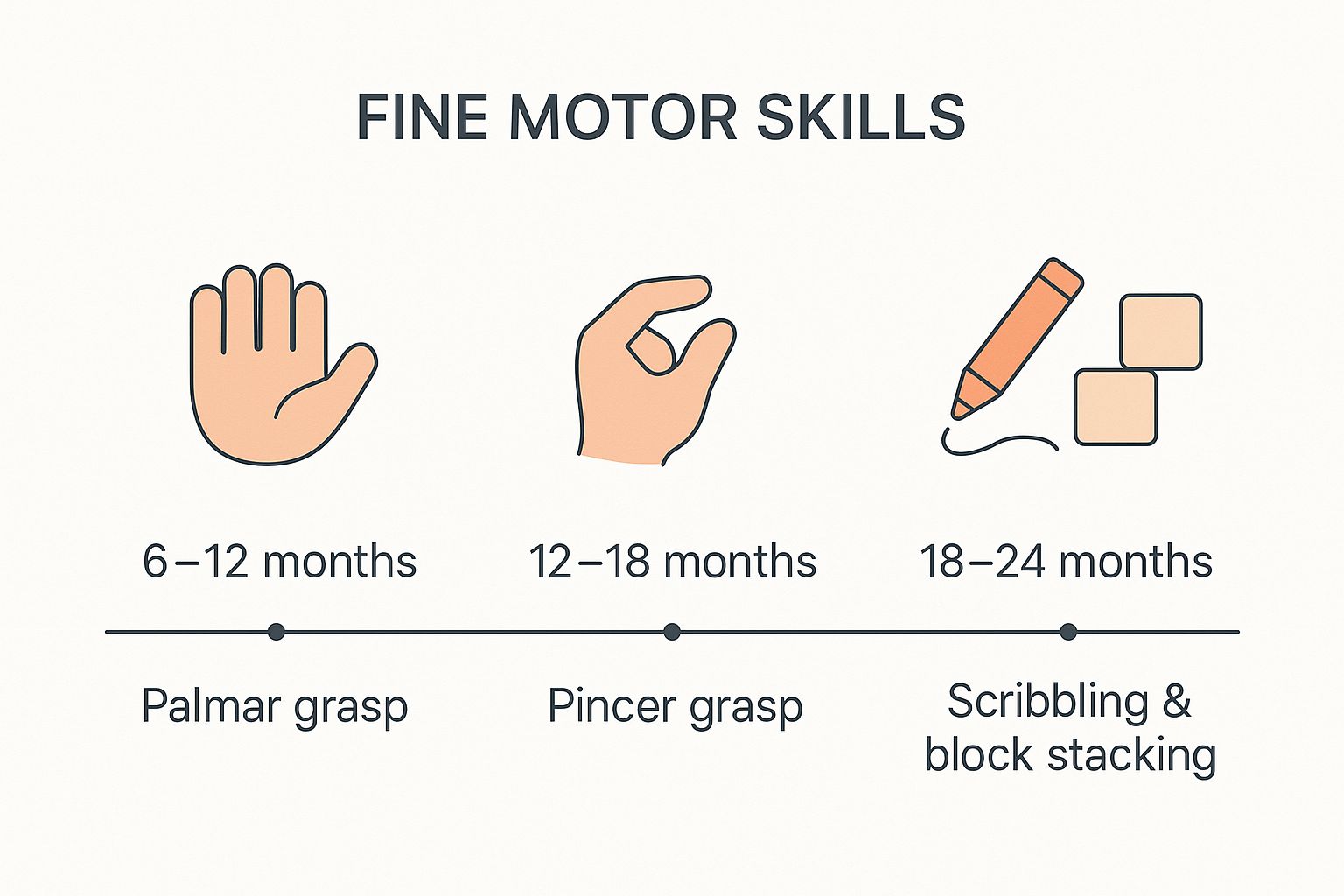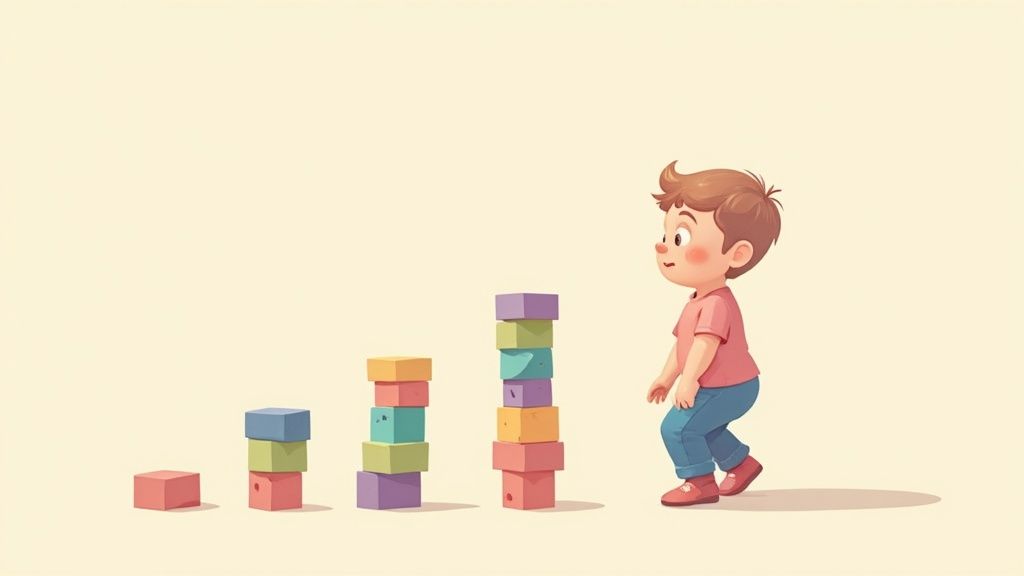What Are Fine Motor Skills A Practical Parents Guide
July 29, 2025

So, what are we really talking about when we say "fine motor skills"? It sounds a bit technical, but it’s actually something you see every single day. In a nutshell, we're talking about all those small, precise movements that happen in the hands, fingers, and wrists.
Think of those tiny, focused actions that let your child pick up a single Cheerio, carefully button their own shirt, or hold a crayon with just the right amount of pressure. That’s the magic of fine motor skills at work.
Your Quick Guide to Fine Motor Skills

Picture a watchmaker, hunched over a tiny, intricate timepiece, delicately placing a gear that’s no bigger than a grain of rice. That incredible precision and control? That’s what fine motor skills are all about, just on a playground-and-snack-time scale. These skills are the absolute bedrock for countless daily tasks, paving the way for greater independence and, eventually, success in the classroom.
At their core, fine motor skills are all about the brain, hands, and eyes working together in perfect harmony to get a detailed job done. This covers everything from zipping a jacket and tying shoes to forming letters with a pencil and cutting along a line with scissors. It’s a journey that starts in infancy and blossoms throughout early childhood, building on a sturdy foundation of core body strength. If you're curious about the specific milestones, the developmental charts at ChildDevelopment.com.au offer a fantastic overview.
To really get a handle on this, it helps to see what these skills are made of. Let's break down the key players that team up to make these intricate movements possible.
Key Components of Fine Motor Skills
This table gives a quick snapshot of the different abilities that work together to build strong fine motor control.
| Component | What It Is | Everyday Example |
|---|---|---|
| Hand-Eye Coordination | The brain processing what the eyes see to guide hand movements. | Catching a ball or coloring inside the lines of a drawing. |
| Pincer Grasp | Using just the thumb and index finger to pick up tiny objects. | Pinching a small bead or a single piece of cereal. |
| Hand Strength | The power in the hands and fingers to grip, squeeze, and manipulate. | Squeezing a lump of play-doh or using a hole puncher. |
| Bilateral Coordination | Making both hands work together as a team to complete one task. | Holding paper steady with one hand while cutting with the other. |
As you can see, what looks like a simple action—like stringing beads—is actually a complex coordination of several different abilities. Building these components is exactly what we aim to support with fun, engaging activities.
Of course! Here is the rewritten section, crafted to sound like an experienced human expert, following all your specified requirements.
Why These Small Movements Are a Big Deal
So, we've talked about fine motor skills being all about those tiny muscle movements. But why does that matter so much? Why do we, as parents and educators, get so excited about a toddler successfully putting a block in a hole?
It’s because every single one of those small, deliberate actions is building the foundation for something huge: independence.
Think about the sheer, unadulterated pride on a child's face when they finally zip up their own jacket. That isn't just a win against a tricky zipper; it's a massive confidence boost. These little victories turn frustrating daily routines into "I did it!" moments. They shift a child's role from someone who is always helped to someone who can do.
From "I Can't!" to "I Did It Myself"
We’ve all seen the struggle. A shirt button that won't cooperate. A fork that keeps dropping peas. For a little one, these can be moments of intense frustration. Strong fine motor skills are the bridge that gets them from "I can't!" to "I did it myself."
This newfound control has a ripple effect that goes way beyond just getting dressed or eating. It builds resilience, teaching kids that it's okay to try, fail, and try again. It also nurtures their inner problem-solver as they figure out the exact twist needed to get a lid off a jar or the right way to hold a crayon to make a mark.
The real magic of fine motor skills isn't just about the physical act. It's about empowering children. When a child can pour their own milk or brush their own teeth, they aren't just learning a task—they're building a core belief in their own abilities.
The Superhighway to School Readiness
This growing independence is also a non-negotiable for being ready for school. Classrooms are busy, bustling places, and teachers need to know that kids can manage their own basic needs.
When a child walks into kindergarten able to handle their own stuff, they’re free to focus on the fun parts of learning—like building friendships and discovering new ideas. Here’s how these skills play out in a typical school day:
- Classroom Confidence: A child who can open their lunchbox without help, put on their own shoes, and manage their glue stick feels secure and capable. They belong.
- Following Directions: So much of early schoolwork involves fine motor control. Activities like cutting along a line or placing stickers in a specific spot use the same precision they've been practicing at home.
- Social Skills: Let's face it, kids who don't constantly need an adult's help can play more freely. They can join in on craft projects and games, building social confidence right alongside their peers.
At the end of the day, these small movements are a huge deal because they give our kids the keys to their own world.
The Surprising Link Between Dexterity and Math

Here’s a fun fact that might make you scratch your head: a child's dexterity is one of the biggest clues to how well they'll do in early math. It sounds a little strange, right? What on earth does scribbling with a crayon have to do with adding numbers?
The secret is that our brains don't start with abstract ideas. Before a child grasps what the symbol "3" means, they understand it with their hands. They hold three blocks, count out three crackers, or hold up three fingers. These physical, hands-on moments are the very first building blocks for understanding what numbers actually are.
The control, precision, and spatial smarts needed for fine motor tasks aren't just for the hands—they're actively forging the brain pathways needed for mathematical thinking. When a child carefully sorts beads by color, they're really practicing categorization and pattern-finding, which are the bedrock of math.
How Hands-On Play Builds Math Brains
This isn't just a neat theory; there's solid proof behind it. Study after study has shown a powerful connection between fine motor skills and early school performance, especially in math.
In fact, a major 2016 study found that fine motor skills were a better predictor of early math ability than even a child's reading skills. The research showed how the precise control of hand movements is directly tied to numerical tasks like counting and solving problems. If you're curious, you can dig into the full study about how fine motor skills predict math performance.
This means that every time your child is deep in hands-on play, they're basically doing pre-math homework without even realizing it.
Think of it this way: The hands are the brain's first calculator. Activities that boost hand-eye coordination and finger dexterity are also laying the groundwork for understanding numbers, spotting patterns, and tackling complex problems down the road.
Simple, everyday play suddenly becomes a powerful brain-building exercise. Here’s how common activities translate directly into math readiness:
- Stacking Blocks: This teaches early physics and spatial relationships—concepts like size, balance, bigger, smaller, and "on top of."
- Stringing Beads: This is a fantastic way to develop pattern recognition and one-to-one correspondence, which is a critical skill needed before a child can truly count.
- Playing with Play-Doh: All that rolling, pinching, and shaping gives kids an intuitive feel for volume, measurement, and 3D shapes.
When you encourage your child to manipulate objects with care and focus, you're not just keeping them busy. You're handing them the essential tools they'll need to make sense of the entire world of numbers.
Tracking Your Child's Fine Motor Milestones
So, how can you tell if your little one’s fine motor development is on the right track? The truth is, it’s less like a rigid, clinical checklist and more like watching them level up in their very own video game. Forget stressing about specific benchmarks—think of it as celebrating each new “quest” they complete.
Every child tackles these challenges at their own unique pace. There’s no test to pass here. It’s all about watching them master the small, incredible movements that lay the foundation for a lifetime of independence.
This little timeline gives you a great visual for how these foundational grasps take shape in the early years.

As you can see, it’s a natural progression. Skills build on one another, taking your child from a clumsy, whole-hand grasp to the precise control needed for their first scribbles.
To get a clearer picture, here’s a simplified breakdown of what you might see at different ages.
Fine Motor Development at a Glance
| Age Range | Key Milestones | Simple Activity to Try |
|---|---|---|
| 0-12 months | Raking objects, then developing the pincer grasp (thumb and forefinger). | Place a soft puff or small piece of banana on their highchair tray and watch them try to pick it up. |
| 1-2 years | Stacking a few blocks, holding a chunky crayon, turning pages in a board book. | Hand them a fat crayon and a piece of paper. Let them explore making marks—it's all about the action! |
| 2-3 years | Building taller towers (6+ blocks), unscrewing a lid, making snips with safety scissors. | Play with play-doh. Rolling, squishing, and pinching are fantastic for building hand strength. |
| 3-4 years | Drawing recognizable shapes (like a circle), buttoning a large button, cutting along a line. | Give them safety scissors and old magazines to snip. It doesn't have to be perfect! |
Remember, this chart is just a guide. It's the small, daily interactions and play opportunities that truly make the biggest difference in their development.
The Great Pincer Grasp Quest (Around 9-12 months)
This is a huge one. It’s that magical moment when you see your baby shift from clumsily raking a toy toward them with their whole hand to deliberately using their thumb and forefinger to pick up a single Cheerio. It’s their first major step into a world of refined finger control.
A strong pincer grasp is the foundation for almost every fine motor task to come, from holding a pencil to using a fork or buttoning a shirt. It’s a tiny movement with a massive impact.
The Scribbling and Stacking Stage (Around 1-2 years)
Once they have that pincer grasp unlocked, a whole new world opens up. They’ll start making their first marks on paper with a chunky crayon. There's no artistic intent yet; they’re simply fascinated by cause and effect. At the same time, they'll likely begin stacking a few blocks, a feat that shows their hand-eye coordination and spatial awareness are clicking into place. They’ll probably knock them over more than they stack them, but that’s all part of the fun!
For more hands-on ways to encourage these budding abilities, check out our guide packed with playful ideas for activities that improve fine motor skills.
The Scissor Snipping Era (Around 3-4 years)
As you move into the preschool years, their coordination takes a serious leap forward. This is when they might bravely start using safety scissors, making small, deliberate snips in paper. You’ll also notice them drawing recognizable shapes, like circles, and their block towers will get impressively tall. These activities show they’re getting much better at using both hands together and controlling their movements with a specific goal in mind.
Building Skills with Playful Coloring Activities
This is where strengthening fine motor skills gets really fun. Let's be honest, repetitive drills are boring for everyone involved. Instead, we can wrap up all that important skill-building in a creative adventure that most kids already love: coloring. It’s so much more than a simple way to keep them busy; coloring is a quiet powerhouse for developing fine motor control.
Think about what's actually happening when a child colors. The simple act of gripping a crayon or marker is a mini-workout for their hands and fingers, building essential strength. Trying to stay within the lines isn't just about being neat—it's high-level practice for hand-eye coordination. Even deciding which color to use next is a small exercise in planning and decision-making.
The connection between these little hand movements and brain development is surprisingly deep. In fact, research shows a direct link between manual dexterity and how kids first learn about numbers, often by using their fingers to count. It's a fascinating look at how physical actions support cognitive learning.
Supercharge Engagement with Customization
Now, what if you could take the power of coloring and make it deeply personal? This is where the real magic happens. When practice is wrapped in something a child is genuinely passionate about, it stops feeling like work entirely.
For example, a tool like ColorPageAI lets a child generate a coloring page based on whatever wild idea they have at that moment.

Imagine your space-obsessed kid getting a custom-made coloring sheet of a super-detailed rocket ship they described themselves. Their engagement skyrockets. That personal connection keeps them focused and happily coloring for much longer, giving them more time to practice those crucial skills without any pressure.
Customization turns a standard activity into a meaningful experience. It meets kids right where their interests are, making them the director of their own creative, skill-building playtime.
This approach doesn't just build physical skills; it validates a child's unique personality. It tells them their interests are cool and important, boosting their confidence and encouraging them to express themselves.
If you're looking for more ways to make practice feel like play, check out our complete guide to fine motor skills development activities. At the end of the day, turning skill-building into joyful play is the secret to success.
Of course! Here is the rewritten section, crafted to sound like an experienced human expert while following all your specific instructions.
Your Top Questions, Answered
As a parent, once you start digging into a topic like fine motor skills, a million questions can pop up. It's a big concept, and it's not always obvious how it all fits together in your child's day-to-day life. Let's walk through some of the most common questions I hear from parents.
What's the Difference Between Fine and Gross Motor Skills?
I always tell parents to think of it as "big muscles versus small muscles."
Gross motor skills are all about the big stuff. They use the large muscle groups in the arms, legs, and torso for whole-body movements—think running across the yard, jumping on the bed, or climbing the playground ladder. These skills give your child power and stability.
Fine motor skills, on the other hand, are the delicate, precise movements. They happen in the small muscles of the hands, fingers, and wrists. We're talking about things like picking up a single Cheerio, zipping a jacket, or, you guessed it, holding a crayon. What's cool is how they're connected; strong gross motor skills (like a stable core from all that climbing!) actually create the foundation for steady, controlled fine motor movements.
My Child Hates Writing. How Can I Help?
This is such a common struggle, so first, know you're not alone. If trying to practice letters turns into a meltdown, my best advice is to put the pencil down and pivot. Many kids resist formal writing but will happily spend an hour doing something else that strengthens the exact same muscles.
The trick is to focus on the fun, not the "practice." Things like squishing and rolling Play-Doh, using kitchen tongs to pick up cotton balls, or stringing beads are all fantastic for building the hand strength and coordination needed for writing—all without the pressure.
Are Tablets Bad for My Child's Skills?
It's all about balance. The swiping and tapping motions on a tablet are pretty simple and repetitive. They don't challenge the tiny muscles in the hand and wrist in the same way that interacting with real, three-dimensional objects does.
There's just no substitute for the hands-on work of building with blocks, snipping with scissors, or gripping a chunky crayon. Those are the activities that truly build the dexterity and strength they’ll need for everything from tying shoes to writing their name. So, make sure they get plenty of screen-free, hands-on playtime every day. For some great, non-digital ideas, check out these fun activities for kindergarten that are secretly skill-builders.
Ready to turn skill-building into a creative adventure? With ColorPageAI, you can generate endless, personalized coloring pages based on your child's favorite things. Give them a fun tool that strengthens their hands and sparks their imagination. Create your first five pages for free at https://colorpage.ai.
Ready to start coloring?
Join ColorPage.ai today and get 5 free credits to create your own custom coloring pages!
Start creating